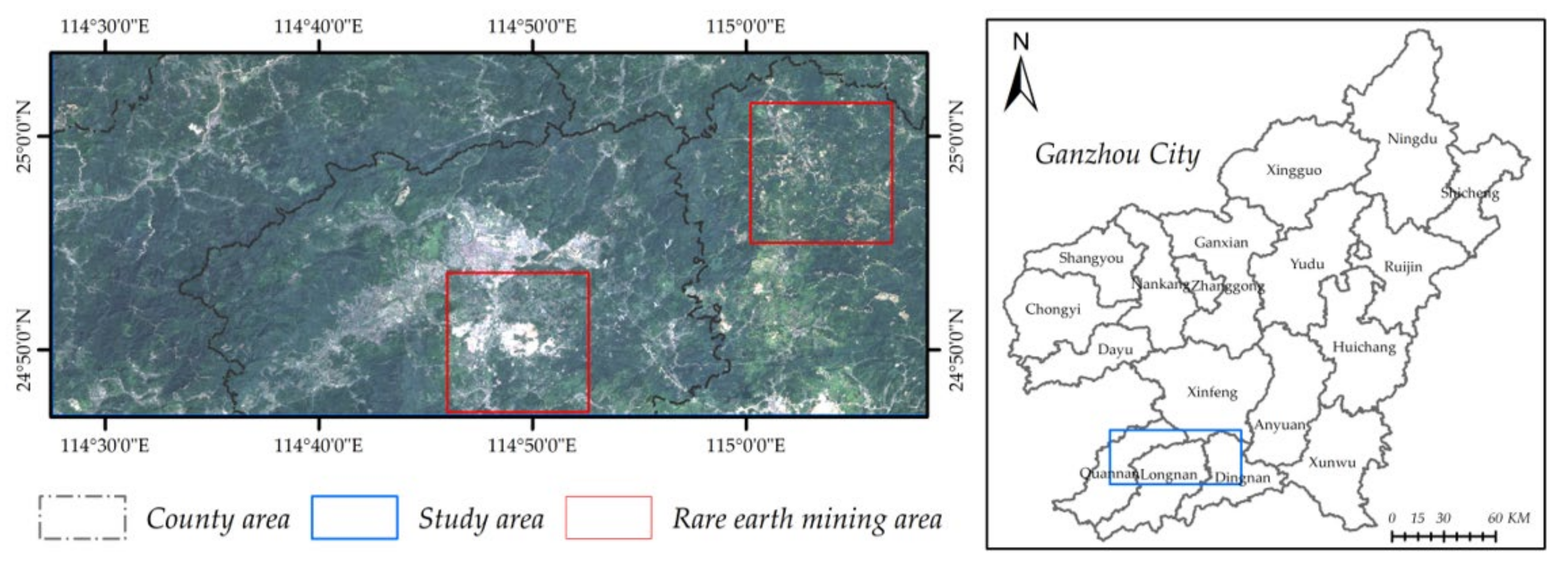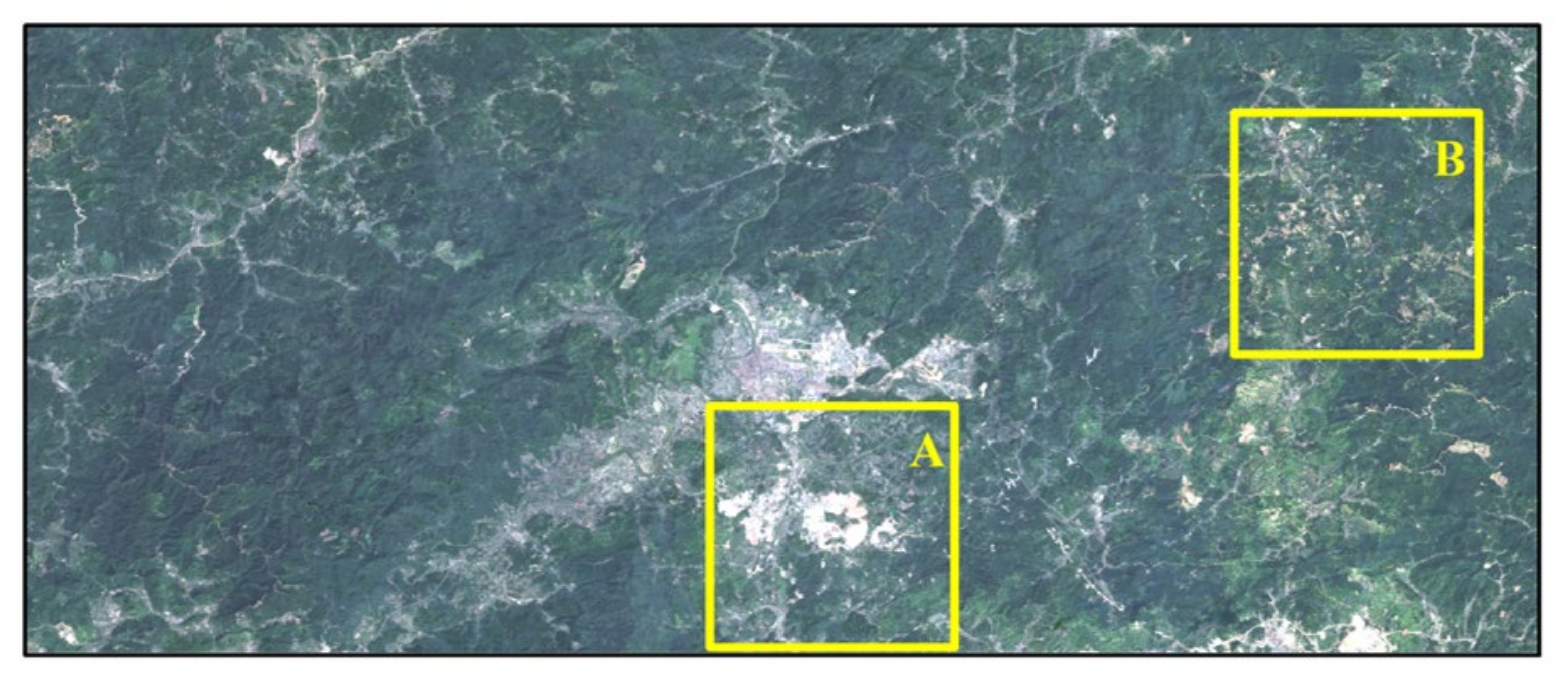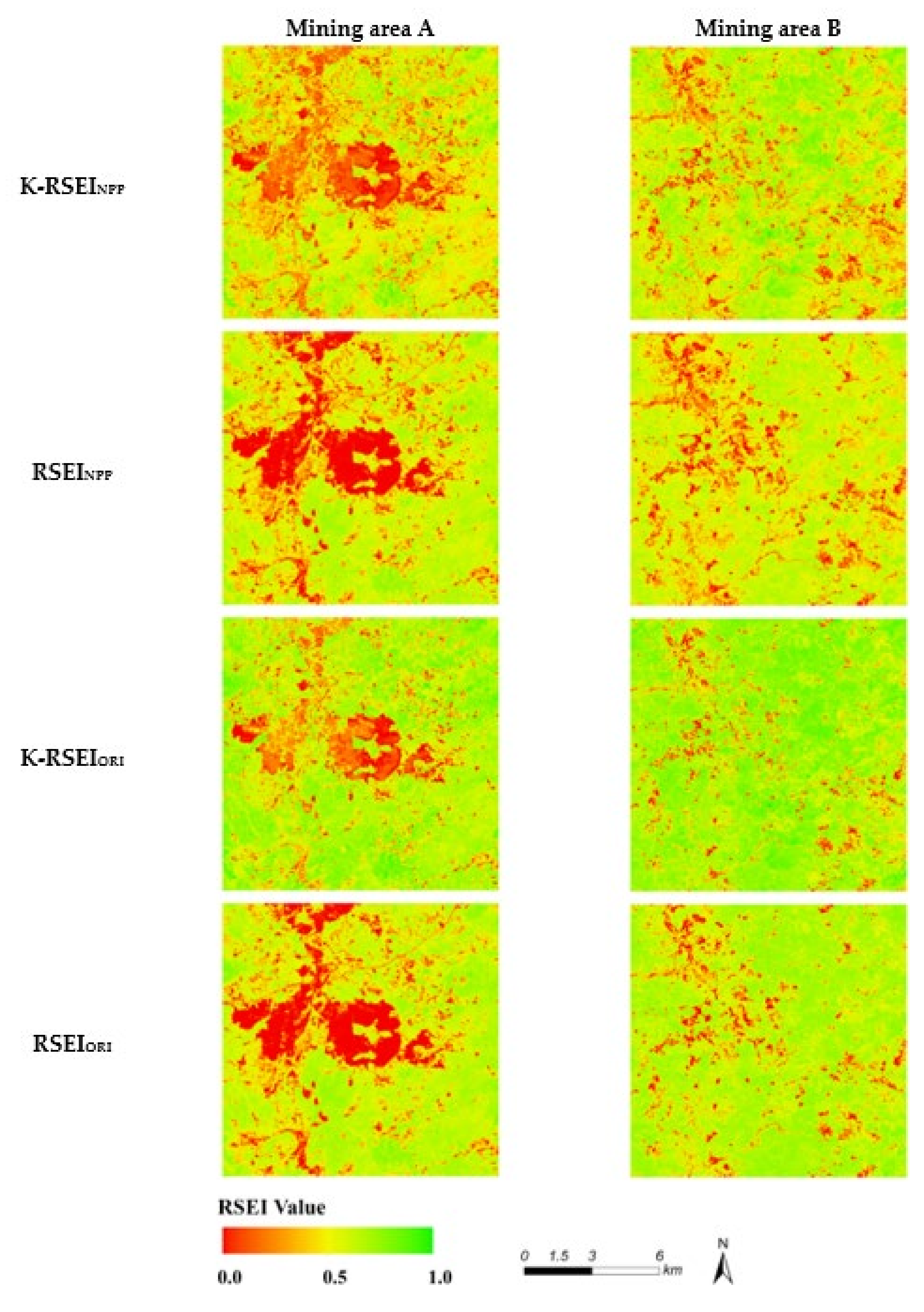Assessment of Ecological Environment Quality in Rare Earth Mining Areas Based on Improved RSEI
Abstract
:1. Introduction
2. Materials
2.1. Study Area
2.2. Data and Preprocessing
2.2.1. Satellite Images
2.2.2. Auxiliary Data
3. Methods
3.1. Indicators Extraction
3.1.1. Greenness
3.1.2. Moisture
3.1.3. Dryness
3.1.4. Heat
3.2. RSEI Calculation
3.3. Combination Scheme and Grading
3.4. Correlation Analysis
4. Results
4.1. Comparative Analysis of RSEI Indicators and Results
4.2. Ecological Environment Quality Analysis
5. Discussion
6. Conclusions
- PC1 obtained from K-RSEINPP proposed in this paper accounts for 88.51% of the results, the highest among the four RSEIs. Meanwhile, the average correlation coefficient between the results and each index reaches 0.757, which indicates that this method can better integrate the characteristics of the four indicators;
- Surpassing PCA, KPCA can obtain results that better represent the ecological environment quality of small-area ground objects and transition zones of different land types. On top of that, compared with NDVI, NPP also reflects the vegetation status in a more detailed manner. The results of K-RSEINPP more meticulously display the ecological environment quality of mining areas, cities in different development stages, and areas with different vegetation coverage and are basically consistent with the actual verification results;
- K-RSEINPP proposed in this paper reflects the ecological environment of rare earth mining areas more accurately than the traditional RSEI and has more detailed information on the ecological environment quality of small areas. It indicates that this method can be effectively applied to the ecological environment quality evaluation of rare earth mining areas in the study area; at the same time, it can also provide an effective reference and research basis for ecological environment monitoring and the evaluation of mining areas in other regions;
- Admittedly, this study has its shortcomings. Specifically, the relatively complicated NPP calculation requires a lot of data, the KPCA algorithm a large amount of calculation, and low efficiency can limit the performance of K-RSEINPP in ecological environment evaluations of large-scale regions, all of which should be addressed in future research.
Author Contributions
Funding
Data Availability Statement
Conflicts of Interest
References
- Xie, L.; Wu, W.; Huang, X.; Ou, P.; Lin, Z.; Zhiling, W.; Song, Y.; Lang, T.; Huangfu, W.; Zhang, Y.; et al. Mining and Restoration Monitoring of Rare Earth Element (REE) Exploitation by New Remote Sensing Indicators in Southern Jiangxi, China. Remote Sens. 2020, 12, 3558. [Google Scholar] [CrossRef]
- Yang, X.; Liu, Z.; Hu, F.; Lin, Y.; Zhang, J.; Lu, C.; Shen, C. Soil Rare Earth Element and Nitride Pollution on Plant Growth and Physiology(Review). Zhongguo Xitu Xuebao/J. Chin. Rare Earth Soc. 2019, 37, 1–11. [Google Scholar]
- Luo, X.; Zhang, Y.; Zhou, H.; He, K.; Luo, C.; Liu, Z.; Tang, X. Review on the Development and Utilization of Ionic Rare Earth Ore. Minerals 2022, 12, 554. [Google Scholar] [CrossRef]
- Xu, F.; Li, H.; Wang, X. Progress in Environmental Problems and Cost Assessment of Ion-adsorption Rare Earth Mining. Chin. Rare Earths 2020, 41, 119–127. [Google Scholar]
- LI Wenchang, L.J.X.G. Critical minerals in China: Current status, research focus and resource strategic analysis. Earth Sci. Front. 2022, 29, 1. [Google Scholar]
- Li, Y.; Li, H.; Xu, F. Comparison of Remote Sensing Monitoring Methods for Land Desertification in Ion-adsorption Rare Earth Mining Areas. Chin. Rare Earths 2021, 42, 9–20. [Google Scholar]
- Wang, X.; Gong, W.; Huang, X.; Liu, T.; Zhou, Y.; Li, H. Assessment of Eco-environmental Quality on Land Use and Land Cover Changes Using Remote Sensing and GIS: A Case Study of Miyun County. Nat. Environ. Pollut. Technol. 2018, 17, 739–746. [Google Scholar]
- Ie, A.D.; Jones, M.; OMahony, T.; Byrne, G. Selecting environmental indicator for use in strategic environmental assessment. Environ. Impact Assess. Rev. 2007, 27, 161–175. [Google Scholar]
- Sullivan, C.; Skeffington, M.S.; Gormally, M.; Finn, J. The ecological status of grasslands on lowland farmlands in western Ireland and implications for grassland classification and nature value assessment. Biol. Conserv. 2010, 143, 1529–1539. [Google Scholar] [CrossRef]
- Li, H.; Li, D.; Li, Y. A multi-index assessment method for evaluating coverage effectiveness of remote sensing satellite. Chin. J. Aeronaut. 2018, 31, 2023–2033. [Google Scholar] [CrossRef]
- Xu, H.Q.V.C. A remote sensing urban ecological index and its application(Article). Shengtai Xuebao/Acta Ecol. Sin. 2013, 33, 7853–7862. [Google Scholar]
- Xu, H.; Wang, Y.; Guan, H.; Shi, T.; Hu, X. Detecting Ecological Changes with a Remote Sensing Based Ecological Index (RSEI) Produced Time Series and Change Vector Analysis. Remote Sens. 2019, 11, 2345. [Google Scholar] [CrossRef]
- Geng, J.; Yu, K.; Xie, Z.; Zhao, G.; Ai, J.; Yang, L.; Yang, H.; Liu, J. Analysis of Spatiotemporal Variation and Drivers of Ecological Quality in Fuzhou Based on RSEI. Remote Sens. 2022, 14, 4900. [Google Scholar] [CrossRef]
- Xiong, Y.; Xu, W.; Lu, N.; Huang, S.; Wu, C.; Wang, L.; Dai, F.; Kou, W. Assessment of spatial–temporal changes of ecological environment quality based on RSEI and GEE: A case study in Erhai Lake Basin, Yunnan province, China. Ecol. Indic. 2021, 125, 107518. [Google Scholar] [CrossRef]
- Ning, L.; Jiayao, W.; Fen, Q. The improvement of ecological environment index model RSEI. Arab. J. Geosci. 2020, 13, 403. [Google Scholar] [CrossRef]
- Hengkai, L.; Feng, X.; Qin, L. Remote sensing monitoring of land damage and restoration in rare earth mining areas in 6 counties in southern Jiangxi based on multisource sequential images. J. Environ. Manag. 2020, 267, 110653. [Google Scholar] [CrossRef]
- Ghorbani, A.; Dadjou, F.; Moameri, M.; Biswas, A. Estimating Aboveground Net Primary Production (ANPP) Using Landsat 8-Based Indices: A Case Study From Hir-Neur Rangelands, Iran. Rangel. Ecol. Manag. 2020, 73, 649–657. [Google Scholar] [CrossRef]
- Ying, L.; Chaoya, D.; Hui, Y.; Lv, C.; Jiaxin, Q.; Rong, Z. Comparison between modified remote sensing ecological index and RSEI. Natl. Remote Sens. Bull. 2022, 26, 683–697. [Google Scholar]
- Liu, C.; Liu, J.; Zhang, Q.; Ci, H.; Gulakhmadov, X.G.A.A. Attribution of NDVI Dynamics over the Globe from 1982 to 2015. Remote Sens. 2022, 14, 2706. [Google Scholar] [CrossRef]
- Gan, L.; Cao, X.; Chen, X.; Dong, Q.; Cui, X.; Chen, J. Comparison of MODIS-based vegetation indices and methods for winter wheat green-up date detection in Huanghuai region of China. Agric. For. Meteorol. 2020, 288–289, 108019. [Google Scholar] [CrossRef]
- Jinguo, Y.; Zheng, N.; Chenli, W. Vegetation NPP distribution based on MODIS data; CASA model―A case study of northern Hebei Province. Chin. Geogr. Sci. 2006, 16, 334–341. [Google Scholar]
- Yu, D.Y.D.; Shi, P.S.P.; Shao, H.S.H.; Zhu, W.Z.W.; Pan, Y.P.Y.H. Modelling net primary productivity of terrestrial ecosystems in East Asia based on an improved CASA ecosystem model. Int. J. Remote Sens. 2009, 30, 4851–4866. [Google Scholar] [CrossRef]
- Zhu, W.; Pan, Y.; Hu, H.; Li, J.; Gong, P. Estimating net primary productivity of terrestrial vegetation based on remote sensing: A case study in Inner Mongolia, China. In Proceedings of the IGARSS 2004 IEEE International Geoscience and Remote Sensing Symposium, Anchorage, AK, USA, 20–24 September 2004. [Google Scholar]
- Zhu, W.Z.W.; Pan, Y.P.Y.; He, H.H.H.; Yu, D.Y.D.; Hu, H.H.H. Simulation of maximum light use efficiency for some typical vegetation types in China. Chin. Sci. Bull. 2006, 51, 457–463. [Google Scholar] [CrossRef]
- Wenquan, Z.; Yaozhong, P.; Jinshui, Z. Estimation of Net Primary Productivity of Chinese Terrestrial Vegetation Based on Remote Sensing. J. Plant Ecol. 2007, 31, 413–424. [Google Scholar] [CrossRef]
- Li-ping, Y.; Cheng-lei, H.; Mei-ling, Z.; Yu-xing, B.; Zhi-qiang, S. Study on Soil Moisture Content Inversion in an Arid Area Based on Landsat-8 Imagery. Chin. J. Soil Sci. 2021, 52, 47–54. [Google Scholar]
- Wen, X.L.; Ming, Y.L.; Gao, Y.G.; Hu, X.Y. Dynamic Monitoring and Analysis of Ecological Quality of Pingtan Comprehensive Experimental Zone, a New Type of Sea Island City, Based on RSEI. Sustainability 2020, 12, 21. [Google Scholar] [CrossRef]
- Hang, X.; Luo, X.; Cao, Y.; Li, Y. Ecological quality assessment and the impact of urbanization based on RSEI model for Nanjing, Jiangsu Province, China. J. Appl. Ecol. 2020, 31, 219–229. [Google Scholar]
- Aemail, M.U.; Sup, A. Analyses of land surface temperature (LST) variability among local climate zones (LCZs) comparing Landsat-8 and ENVI-met model data. Sustain. Cities Soc. 2021, 69, 102877. [Google Scholar]
- Zhang, Y.; She, J.; Long, X.; Zhang, M. Spatio-temporal evolution and driving factors of eco-environmental quality based on RSEI in Chang-Zhu-Tan metropolitan circle, central China. Ecol. Indic. 2022, 144, 109436. [Google Scholar] [CrossRef]
- Nie, X.; Hu, Z.; Zhu, Q.; Ruan, M. Research on Temporal and Spatial Resolution and the Driving Forces of Ecological Environment Quality in Coal Mining Areas Considering Topographic Correction. Remote Sens. 2021, 31, 2815. [Google Scholar] [CrossRef]
- Li, J.; Liang, J.; Wu, Y.; Yin, S.; Yang, Z.; Hu, Z. Quantitative evaluation of ecological cumulative effect in mining area using a pixel-based time series model of ecosystem service value. Ecol. Indic. 2021, 120, 106873. [Google Scholar] [CrossRef]
- Xu, F.; Li, H.; Li, Y. Ecological environment quality evaluation and evolution analysis of a rare earth mining area under different disturbance conditions. Environ. Geochem. Health 2021, 43, 2243–2256. [Google Scholar] [CrossRef]




| Scheme | Name | Selected Index | Calculation |
|---|---|---|---|
| 1 | K-RSEINPP | NPP, LST, WET, NDBSI | KPCA |
| 2 | RSEINPP | NPP, LST, WET, NDBSI | PCA |
| 3 | K-RSEIORI | NDVI, LST, WET, NDBSI | KPCA |
| 4 | RSEIORI | NDVI, LST, WET, NDBSI | PCA |
| NO. | 1 | 2 | 3 | 4 | 5 |
|---|---|---|---|---|---|
| Value range of RSEI | [0–0.2) | [0.2–0.4) | [0.4–0.6) | [0.6–0.8) | [0.8–1.0) |
| Ecological quality level | Poor | Less-poor | Medium | less-premium | premium |
| Results | Contribution | |||
|---|---|---|---|---|
| PC1 | PC2 | PC3 | PC4 | |
| K-RSEINPP | 88.51% | 6.54% | 3.12% | 1.82% |
| RSEINPP | 72.32% | 18.83% | 6.06% | 2.79% |
| K-RSEIORI | 85.66% | 7.24% | 4.89% | 2.20% |
| RSEIORI | 67.84% | 16.28% | 6.77% | 9.11% |
| Index * | NPP | NDVI | WET | NDBSI | LST |
|---|---|---|---|---|---|
| NPP | 1 | 0.707 | 0.543 | −0.562 | −0.469 |
| NDVI | 1 | 0.698 | −0.856 | −0.603 | |
| WET | 1 | −0.725 | −0.584 | ||
| NDBSI | 1 | 0.616 | |||
| LST | 1 | ||||
| K-RSEINPP | 0.872 | — | 0.768 | −0.702 | −0.687 |
| RSEINPP | 0.839 | — | 0.647 | −0.688 | −0.502 |
| K-RSEIORI | — | 0.853 | 0.702 | −0.726 | −0.623 |
| RSEIORI | — | 0.723 | 0.674 | −0.667 | −0.514 |
| Results | Area Ratio of Each RSEI Grade (%) | ||||
|---|---|---|---|---|---|
| Poor [0–0.2) | Less-Poor [0.2–0.4) | Medium [0.4–0.6) | Less-Premium [0.6–0.8) | Premium [0.8–1.0) | |
| K-RSEINPP | 9.21 | 18.65 | 31.05 | 22.76 | 18.33 |
| RSEINPP | 15.63 | 13.37 | 37.15 | 13.25 | 20.60 |
| K-RSEIORI | 14.21 | 18.95 | 35.23 | 12.56 | 19.05 |
| RSEIORI | 25.28 | 14.37 | 26.23 | 11.85 | 22.27 |
Disclaimer/Publisher’s Note: The statements, opinions and data contained in all publications are solely those of the individual author(s) and contributor(s) and not of MDPI and/or the editor(s). MDPI and/or the editor(s) disclaim responsibility for any injury to people or property resulting from any ideas, methods, instructions or products referred to in the content. |
© 2023 by the authors. Licensee MDPI, Basel, Switzerland. This article is an open access article distributed under the terms and conditions of the Creative Commons Attribution (CC BY) license (https://creativecommons.org/licenses/by/4.0/).
Share and Cite
Yang, W.; Zhou, Y.; Li, C. Assessment of Ecological Environment Quality in Rare Earth Mining Areas Based on Improved RSEI. Sustainability 2023, 15, 2964. https://doi.org/10.3390/su15042964
Yang W, Zhou Y, Li C. Assessment of Ecological Environment Quality in Rare Earth Mining Areas Based on Improved RSEI. Sustainability. 2023; 15(4):2964. https://doi.org/10.3390/su15042964
Chicago/Turabian StyleYang, Weilong, Yi Zhou, and Chaozhu Li. 2023. "Assessment of Ecological Environment Quality in Rare Earth Mining Areas Based on Improved RSEI" Sustainability 15, no. 4: 2964. https://doi.org/10.3390/su15042964





